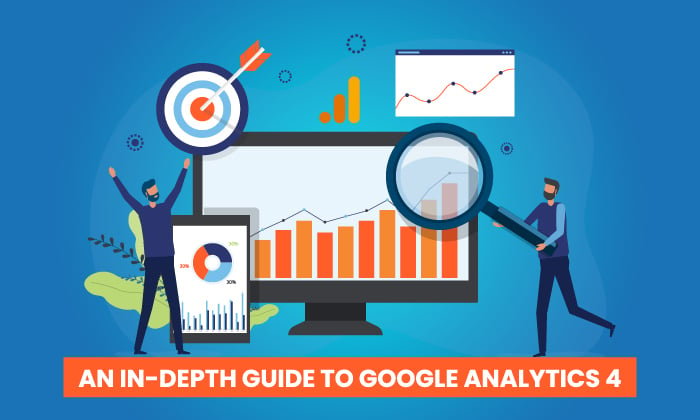
When it comes to website analytics, Google Analytics is second to none.
With the rollout of the latest release, Google Analytics 4 (GA4), the same can now be said of applications analytics, too.
Google Analytics 4 was designed to be the latest generation of web analytics platforms—providing a base for marketers around the world to effectively analyze important customer usage metrics.
New report functions, enhanced features, and predictive insights make it an essential addition to any current Google Analytics setup.
What Is Google Analytics 4?
Google Analytics 4 (formerly known as App+Web), is a new property available on Google Analytics. It replaces the former property type “Universal Analytics.”
The latest generation of Google Analytics sells itself as focused on customer privacy. This comes in the face of some of the latest privacy laws, such as GDPR and CCPA. With privacy-first tracking, cross-channel data measurement, and AI-driven predictive analytics, GA4 is certainly an advanced property that many websites and apps will benefit from.
Google Analytics 4 Vs. Google Analytics (Universal Analytics)
The most obvious difference between Google Analytics 4 and Universal Analytics is that GA4 is a property that enables you to report on websites and applications. Universal Analytics only supports website analytics.
The measurement model itself is also different between the two.
Google Analytics 4 uses a new model that measures events and parameters. Universal Analytics uses a model based on sessions and pageviews.
That’s not all, however. GA4 has an array of new metrics. These include engagement metrics such as:
- engaged sessions
- engagement rate
- engagement time
What Are the Benefits of Google Analytics 4?
Google Analytics 4 offers numerous benefits to users. Here are a few that stand out against the older generation of the property.
Cross-Platform Tracking
What happens when users are active on more than one platform? With the old Google Analytics, it was a manual process that took time and effort. The new Google Analytics 4 tracks both web and app data in one property (hence the beta name of Google Analytics App+Web).
Cross-platform tracking enables you to see the complete customer journey, including acquisition, engagement, monetization, and retention. You can use GA4 to track the user experience from start to finish—and from platform to platform.
This is done through unique user IDs assigned during app or website login.
With the appropriate gtag.js script, the user ID for each logged-in session will be sent from either the website or the application to Google Analytics. The ID will be reported to the GA4 property and any user metrics will be logged. When the user logs in again on an alternative platform, the reports will connect the user’s data to their unique ID and pick up where it left off.
This is incredibly useful information for any marketer, as it allows you to better understand the cross-platform experience of your users. The data can also be used to extrapolate information for a generalized demographic and build more accurate customer models.
All Measurements Are Events
With Universal Analytics, page views were the most important metric. This, and other hit metrics such as screen time, events, and transactions, were tracked extensively. The problem is that this gives a myopic view of customer interactions.
With Google Analytics 4, all measurements are events. What does this mean for you?
Instead of measuring at just the session level, GA4 collects and stores all user interactions as separate events. You can still view session-level reporting, but the ability to break it down by interaction means more in-depth reports and insights.
Instead of seeing generalized data, you can now gain a fuller understanding of your individual users when it suits your needs.
AI Insights for Predictive Metrics
While looking at past behaviors is helpful in understanding your audience, it doesn’t enable you to always make proactive decisions. With GA4’s powered predictive metrics, you can make data-driven decisions on a large scale.
What does this look like? For most businesses, predictive analytics can significantly impact retargeting campaigns. The metrics included in GA4 as of this writing are:
- purchase probability
- churn probability
- revenue prediction
With the above metrics, you can create audiences based on their predicted behaviors. For example, users who are likely to purchase in the next 7 days or users that are likely to spend more than $500 in one shop.
These audiences can then be targeted using active Google Ads campaigns or even on social media.
These metrics cannot only help to improve retargeting campaign success, but also improve website performance. You can create custom funnels for different audiences based on their behaviors and needs. The suggestions will continue to improve as more data is collected.
More Control
The greater the control you have over the data, the more you can do with it. While the Universal Analytics property has no shortage of data, it does have a lack of user control. You can create custom reports to a certain extent, but in many cases the customization possibilities are limited.
Google Analytics 4 offers more flexibility than the old Google Analytics. With GA4, you can create your own dashboard, enabling you to see the reports that matter most to your business. It even works well in conjunction with Google Data Studio so you can create custom visualizations of the data collected.
Even more than greater control over specific reporting, GA4 offers expanded segmentation capabilities.
With GA4, you can create segments based on events which are essentially a subset of events that occurred on your website or application. This enables you to more accurately track customer interactions. For example, you can create segments on all conversion events that occurred in a particular location. These capabilities make it possible to take a more granular view of your users and their behaviors.
Should I Make the Switch to Google Analytics 4?
While the switch to Google Analytics 4 may seem overwhelming, it’s important to start gathering data for future use as soon as possible. The thing to remember is that Google Analytics 4 can only collect data from the date it is set up and enabled. It cannot collect historical data prior to that time.
There has been no word from Google whether Universal Analytics will become obsolete in the future. However, it’s best to get used to the new property while you still have the time. The good news is you can have both a Universal Analytics property and a Google Analytics 4 property for your account. They will run side-by-side collecting data so you can begin to accustom yourself to the new property without losing your current reporting capabilities.
How to Set Up Google Analytics 4
Since Google Analytics 4 can be used for your website or application (or both), there are two separate setup processes. They are outlined below.
Alongside an Existing Property
If you currently have a Universal Analytics property for your website, then setup of a Google Analytics 4 property can be completed with the GA4 Setup Assistant.
- In Google Analytics, click “Admin” on the lower left of the screen.
- In the Account column, select the desired account:
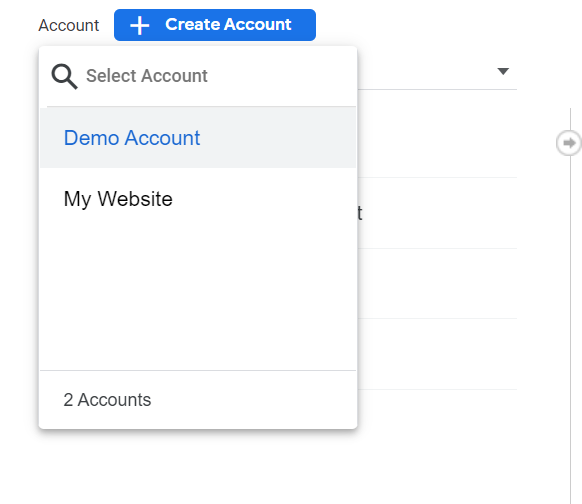
- In the Property column, select the Universal Analytics property that currently collects data for your website:
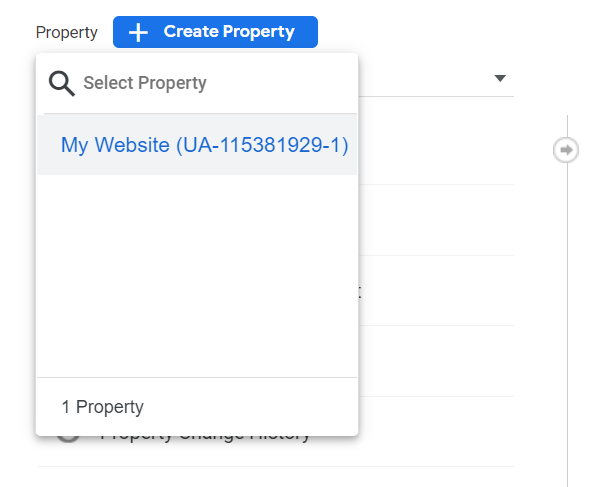
- In the Property column, select GA4 Setup Assistant:
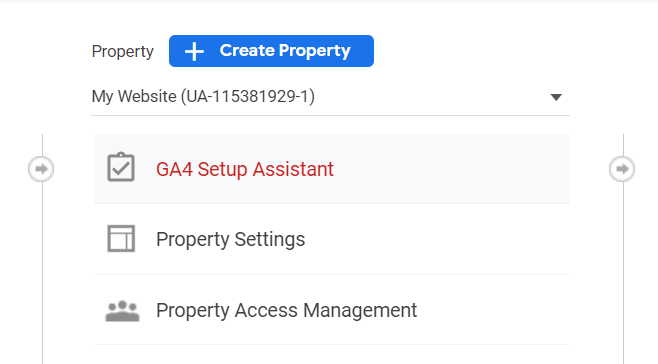
- Click “Get started” under “I want to create a new Google Analytics 4 property:”

- If your site uses the gtag.js tag, you can select “Enable data collection using your existing tags.”
- Click “Create Property.”
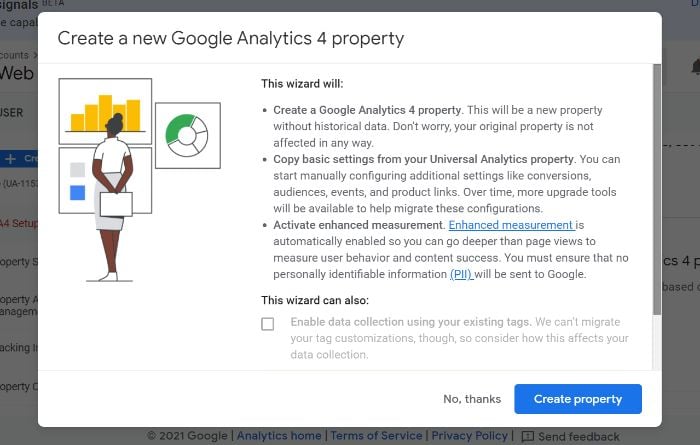
If you are unable to “Enable data collection using your existing tags,” it’s for one of three reasons:
- Your website builder/CMS doesn’t yet support the gtag.js tag.
- You use Google Tag Manager.
- Your website is tagged with analytics.js.
In all three cases, you’ll need to add the tag yourself.
Google Analytics for Firebase
To upgrade your Firebase account to Google Analytics 4, follow these steps:
- Log in to the Firebase console.
- Go to Analytics > Dashboard on the left panel.
- Click “Begin upgrade” in the banner at the top of the page.
- Follow the on-screen instructions to complete the upgrade.
Once upgraded, you can find app analytics in both the Firebase console and Google Analytics.
Frequently Asked Questions About Google Analytics 4
What is Google Analytics 4?
What is the difference between Google Analytics 4 and the old GA?
Is Google Analytics 4 free?
Are they getting rid of the old Google Analytics?
An In-Depth Guide to Google Analytics 4: Conclusion
When used to its fullest potential, Google Analytics is a powerful analytics tool that can provide invaluable insights. This is why it’s important to upgrade your account when possible. The latest upgrade available to users is the new property, Google Analytics 4.
There are numerous benefits to GA4, including cross-platform tracking, more control over data, and AI-driven insights. When you create a new GA4 property, it works alongside your current Universal Analytics property while also allowing you to gain additional data for future use. While UA is available indefinitely, the transition to GA4 isn’t mandatory but it’s highly recommended.
Fortunately, setting up a GA4 property on your website or app is easy. The steps as outlined above should take you less than 10 minutes to complete so there’s no excuse to put off the transition.
Which of Google Analytics 4’s features are you most excited about?
from Blog – Neil Patel https://ift.tt/3GbwRdx
via IFTTT
No comments:
Post a Comment